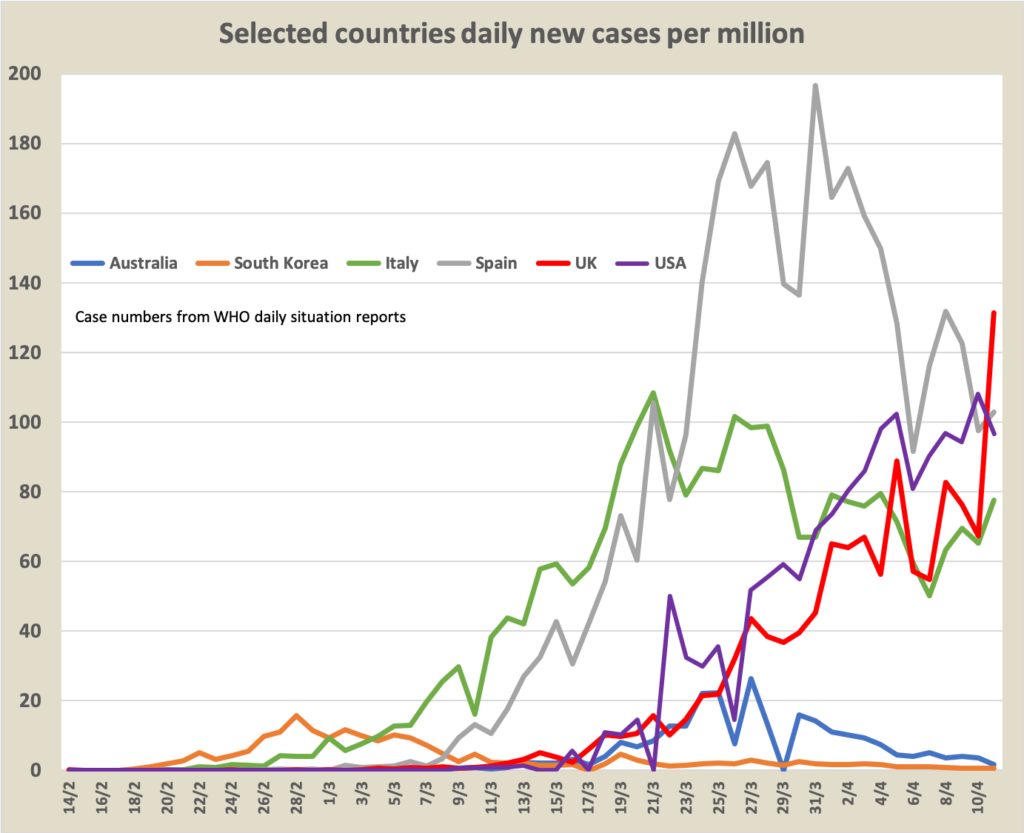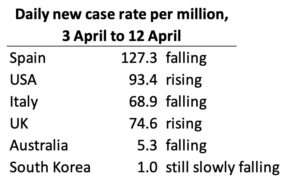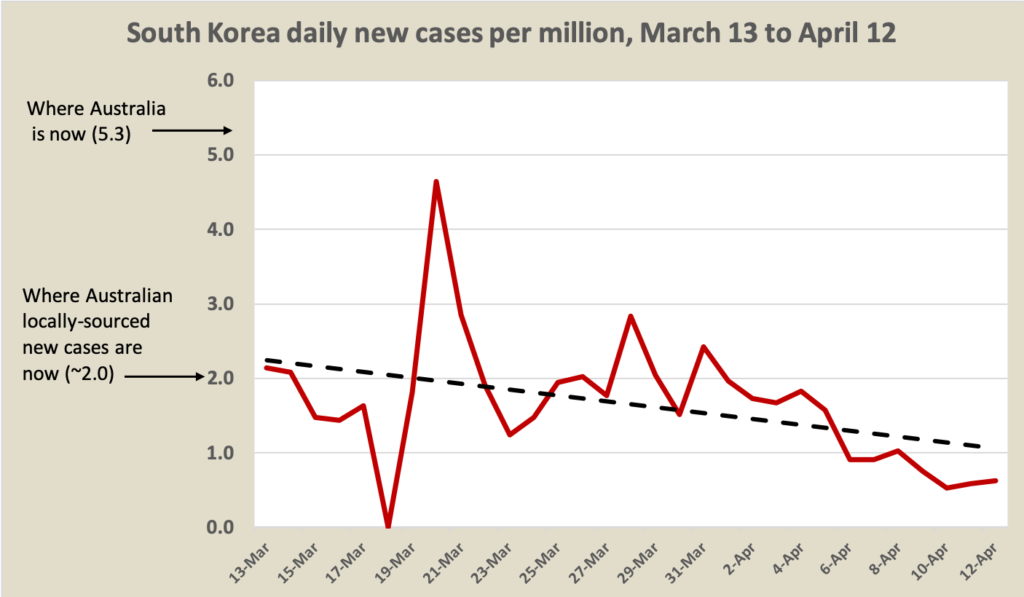The numbers behind the spread of coronavirus in Australia are promising, but we should wait some time before considering any relaxation of social distancing and other restrictions.
Promising news about reduced rates of coronavirus infection have led to people asking what comes now. ABC Insiders host David Speers summarises the situation in an article The coronavirus curve has flattened and now most Australians have changed the question they want answered, the question being “when will life return to normal?”
The short answer is that it would be irresponsible for governments to lift restrictions any time in the next few weeks. Because there is such a long period between infection and development of symptoms, the low rate of new cases we are seeing now relates to our behaviour some weeks back, not to what we are doing now. Chief Medical Officer Brendan has wisely warned against complacency and against relaxing social distancing measures. There are still people in the community transmitting the virus, and there are still people arriving home from overseas.
And even if the virus were to disappear today, the world does not return to its previous state after a disruption like this.
Two ideas in common circulation seem to be clouding our thinking. One is about some trade-off between “health” and “the economy”; the other is about what is meant by “flattening the curve”.
To deal with each in turn.
The economy sits inside society, not alongside it
It shouldn’t be necessary to assert that economic activity – buying, selling, producing – sits within society. We do these things in order to sustain or improve our wellbeing, not because they are important in their own right.
In his 1944 work The Great Transformation the philosopher Karl Polanyi pointed out that since time immemorial markets had existed within society, subject to society’s norms and morals. The great transformation Polanyi feared was that in the postwar order there would emerge the “market society”, in which markets would become decoupled form those norms and moral constraints.
Polanyi’s prophecy has been confirmed. So separated has the idea of “the economy” become from its social origins that economic indicators, far removed from the human situations to which they should refer, have assumed primacy in public policy.
The idea that public policy must somehow strike a “balance” between social and economic outcomes is hard to shake. Journalists, politicians and advocates of all persuasions talk and write about “social” and “economic” objectives as if they separate. That’s even as people’s priorities, influenced by the horrifying succession of images from Italy, Spain and the USA, have led them to seek safety as their first concern. As engraved in the Code of Hammurabi 3800 years ago, and spelled out in national constitutions, the first duty of government is the protection of its citizens.
Flatten the curve? Which curve?
“Flatten the curve” has almost become what linguists call a “floating signifier” – a term to which its user can assign his or her own meaning.
Most commonly it refers to the accumulation of new cases over time, a curve that can only rise or at best flatten. It is indeed desirable to flatten that curve, but that begs the questions “how flat?”, and “what is the path to get to a flattening?”. On the latter question, it would be possible to “flatten the curve” by rapidly letting the entire population become infected, a path initially considered by some governments, and a path that may be grimly unavoidable in some of the world’s poorest and worst-governed countries. The latter question – how do we flatten it, is more relevant for public policy.
From a policy perspective, the most useful indicator is the rate at which new infections are rising – how many new cases a day – and that can be plotted on a different curve. This data is readily available or easily calculated from various websites, but we learn little from knowing that in the USA infections are rising at a rate of 30 000 a day while in the UK they are rising at 5 000 a day, because the USA has five times Britain’s population.
So, in terms of making some sense of these figures. I have generated a graph of the daily accumulation rate per million people for six countries. These are Italy and Spain, the “western” countries where governments were initially caught off guard but are now bringing the rate back; the USA and the UK, where rates are still rising; and Australia and South Korea, where rates seem to have peaked and may be falling back to crawl along the axis. I have not included China because over the period covered by this chart its curve would be indistinguishable from the X axis. Nor have I included any “developing” countries, because data collection depends on testing – a problem relevant to all countries but that is more significant in poor countries where official data as provided by governments to the WHO is almost useless at this stage.

Spain holds the record at 200 cases a day per million but daily peaks do not mean a great deal because testing and detection do not take place at a steady rate. A little smoothing is necessary: the table below shows the average new case rate for the ten days up to April 11. Some of these differences reflect the stage of development: South Korea was an early starter, the USA a late one.

The unbearable absurdity of “herd immunity” (and other proposals to let the virus spread)
This table may help us understand the absurdity of the idea, which fortunately is losing currency, that countries should aim to allow the rate of new cases to rise so as to achieve herd immunity in a short time, and as countries move to that felicitous outcome, more people would be able to resume normal economic life. That rate should be set at one which does not overwhelm the country’s health care system, and does not force health care workers to make harsh triage decisions.
As John Dwyer points out, that idea rests on a brave assumption that those who have had the virus achieve immunity. We don’t know, and it will be months before we will know if such immunity exists, and if it does whether it is permanent.
It also rests on unrealistic arithmetic. Even if we bravely assumed that perhaps the speed limit that just keeps the health care system coping is 60 new cases a day per million, based on UK or Italian experience, (think 500 new cases a day in NSW, ten per cent of whom need hospitalisation), it would take 45 years to achieve 100 per cent immunity (the division is straightforward), or a mere 32 years if such immunity could be achieved with 70 per cent of the population.
Over two years of such a path – a time when better treatments or a vaccine will probably become available – only four per cent of the workforce would have been given an all-clear to resume normal life. However long that period lasts there would have to be strong restrictions (particularly on foreign travel), the health workforce would be exposed to ongoing high risk, and there is no guarantee that a rate can be held. As anyone knows who has ever tried to control a large boat or airplane, or even operate a hot/cold mixer tap in a hotel, regulating a system with a time lag is difficult enough: add the phenomenon of positive feedback manifest in exponential growth and the task becomes impossible.
These figures are rough and subject to uncertainties relating to testing rates, but even if they are out by an order of magnitude they illustrate the point: there is no path to herd immunity that would be tolerable in any democracy.
Where to now for Australia?
Considering Australia’s promising figures, Deputy Chief Medical Officer Paul Kelly has said Australia is “on the cusp” of seeing the virus die out.
Norman Swan, speaking on ABC radio on Monday morning, said there is the “tantalising prospect” that the virus could be eliminated in Australia. (It pays to be girt by sea.) That possibility could make people more willing to tolerate strong controls and restrictions for a period, because they are seen to be having tangible results rather than simply sustaining a holding pattern.
At this stage in Australia we should aim for elimination. As Swan points out we are at a point where we have the incidence of overseas-sourced cases down, but locally-sourced cases are running at about fifty new cases a day (two per million). That’s a very small number, but unless we keep the transmission rate of those cases down (holding the reproduction number “R” less than one) those few cases could rapidly expand to numbers experienced in the USA and Europe.
Even if we cannot eliminate the virus, getting its incidence down to very small numbers would take a huge load off the health care system, and should allow for some lifting of controls and restrictions. If the best we could achieve is one new case per day per million (South Korea’s recent average), that would result, for example, in about eight new cases in NSW each day, one of which requires hospitalisation, one or two new cases a day in South Australia, and a case every second day in Tasmania. But if we do get down to those low numbers we should not rest on our laurels: we should keep on the steady path to elimination, even if the final few steps downward take extra effort.
The figures suggest that South Korea could be heading to elimination. The graph below is a close-up picture of the graph above, showing South Korea’s progress over the last month, and indicating where Australia stands now, the locally-sourced rate being the more relevant number. South Korea’s curve is headed towards the axis.

An elimination strategy requires significant investment in testing (for presence of the virus and for antibodies indicating immunity), particularly in forms of testing that are low-cost and do not expose health care workers to risk: according to experts such tests may be with us shortly. That means public policy should be directed to paying for and mobilising resources for testing and contact tracing. That may mean a few hundred million dollars – small change in comparison with what’s being spent on income support, and insignificant in economic terms if it allows for a move to a higher level of economic activity.
We need to maintain strong controls and restrictions until our curve hits the axis, and then for a few weeks because of asymptomatic cases. From then strict controls on international travel would need to be maintained and large gatherings would probably still be prohibited (we cannot hermetically seal the country). Other controls and restrictions would be lifted very slowly, by stages as we observe their effects. They might not be lifted entirely until there is a vaccine or safe treatment, but they would be much less onerous than they are now. Schools and cafes could probably re-open and some domestic travel restrictions could be eased. If, as in Singapore, there is early evidence of another outbreak, there may need to be short periods of shut-down.
Most importantly, life for most people, particularly young people, would be relatively uninterrupted. Social wellbeing would improve, and as a secondary consideration, those figures on GDP and the fiscal balance may not look quite as bad as we had expected.
Ian McAULEY is a retired lecturer in public sector finance. As an former engineer he is addicted to the numbers behind public policy issues. He is grateful for assistance from John Dwyer in preparing this article.




